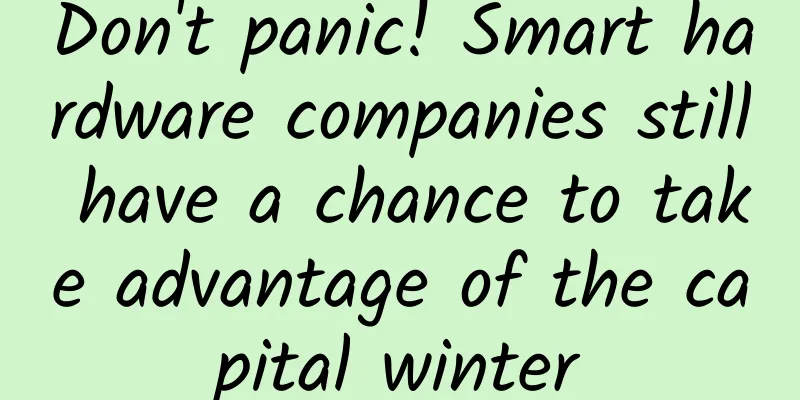Don't panic! Smart hardware companies still have a chance to take advantage of the capital winter

|
After the stock market crash in the second half of this year, the theory of capital winter swept the market. The various actions and voices from investors and the media were enough to make a large number of entrepreneurs feel the chill. Especially in the smart hardware industry with high investment costs and immature industry forms, the high dependence of start-ups on capital makes them more vulnerable to capital dynamics. Recently, the fourth chapter of the smart hardware industry series research report jointly launched by JD Intelligence and iResearch Consulting - Investment Analysis was officially released. The report conducted relevant statistics and analysis on the investment profile of the domestic smart hardware market in the past two years. The data and perspectives in the report may bring some confidence and inspiration to practitioners in the "cold winter". Capital tightening cannot reverse the trend of Internet evolution The report pointed out that the amount of domestic hardware financing in the third quarter of this year showed a downward trend compared with the previous two quarters, but it still showed an upward trend overall. The average investment in hardware (mainly smart hardware) in 2014-2015 was RMB 140 million, ranking second in the sub-sector. It should be pointed out that since the tightening of capital, the number of investments in Series B+ projects has increased instead of decreased. This shows that some smart hardware companies have entered a stage of rapid development and have not been constrained by the decline of the capital market. This to a certain extent supports the view that the Internet of Things is the direction of IT technology evolution. Compared with the mobile Internet era, the traffic scale in the Internet of Things era will grow by leaps and bounds. In fact, not only the Internet of Things, but also smart hardware is the key entry or node of technologies such as big data, cloud computing, and artificial intelligence. The market is still in the cultivation stage, but in the future these products will play an increasingly important role in people's lives. Data shows that from January to September 2015, the number of users who purchased smart hardware products on JD.com doubled year-on-year, and sales increased nearly three times. Its growth rate is still far beyond the reach of most industries. The way out for small and medium-sized players: Return to the essence and take advantage of the favorable conditions Although the prospects are still bright, the challenges brought by the capital cold wave are undoubtedly daunting for any specific smart hardware company. Driven by the previous wave of enthusiasm, all kinds of startups have flooded into the industry. The lack of innovation capabilities and core technologies has directly led to homogeneous competition in the market segments. According to the law of industry development, this stage originally required larger-scale financial support. The cooling of capital at this time will inevitably lead to a large number of companies going to an early end due to lack of money. In fact, even without the impact of the capital market, the smart hardware market is facing problems such as severe homogeneous competition, lack of demand scenarios, and difficulty in breaking through the consumer market. At least one thing is certain about the impact of the capital cold wave: companies that have previously raised funds through concept speculation and high-frequency financing will be eliminated first. After all, the method of burning money for scale is no longer sustainable, and projects with low feasibility are difficult to raise funds. Referring to the Internet bubble in the United States in the 1990s, those companies that focus on products, have clear target markets, and are good at feedback and adjustment will win a higher chance of survival. In addition to returning to the essence of the product, effectively leveraging the power of big players can also help these companies gain a larger living space. The giants carry out industrial layout in the form of platforms, which can more accurately grasp the overall trend of the industry and provide better guarantees for the growth of small and medium-sized players not only in terms of funds but also in all aspects of the product life cycle. Referring to the list of players, the advantages of big platforms in terms of brand, entry, channel, supply chain, etc. are obvious (the specific characteristics of these platforms have been elaborated in detail in "Who can hold the position of smart hardware dealer among the major players?"). Any of these factors may determine the success or failure of small and medium-sized players. Effectively using existing resources and experience can help entrepreneurs avoid many detours. Take JD.com as an example. Since its first investment in the smart hardware industry at the end of 2013, its layout in this field has continued to deepen. At the beginning of the following year, JD.com launched the JD+ project, providing six major supports for smart upgrading and transformation enterprises, including cooperative entry barriers, special resources for marketers, data sharing, cloud computing, APP, and smart chip modules. In 2015, it further laid out the "JD+ ecosystem" and launched an overall solution from smart entrepreneurship incubation, technical platform support, industrial chain integration to financial investment and channel promotion. There are also successful cases on the product side, such as "Liuyun" mobile power supply and "Dingdong" smart speakers. It can be said that JD.com entered the smart hardware industry early and made heavy moves. With its 3C genes, it has formed a unique training program for start-ups. In a sense, the protection of these big players is a gust of east wind that small and medium-sized enterprises in the hardware field can rely on. Of course, having a framework that can hold the wind is an indispensable prerequisite for takeoff. As a winner of Toutiao's Qingyun Plan and Baijiahao's Bai+ Plan, the 2019 Baidu Digital Author of the Year, the Baijiahao's Most Popular Author in the Technology Field, the 2019 Sogou Technology and Culture Author, and the 2021 Baijiahao Quarterly Influential Creator, he has won many awards, including the 2013 Sohu Best Industry Media Person, the 2015 China New Media Entrepreneurship Competition Beijing Third Place, the 2015 Guangmang Experience Award, the 2015 China New Media Entrepreneurship Competition Finals Third Place, and the 2018 Baidu Dynamic Annual Powerful Celebrity. |
<<: IDC: Enterprise market and hybrid devices are boosters for PC market
>>: Hisense's Liu Hongxin: Never rejected OLED, but more optimistic about laser display technology
Recommend
PC Taobao single product analyzer is a must-have for merchants_non-toxic software
Those who understand this tool will naturally und...
Where is Google heading as its PC search business growth stalls?
Google 's financials have remained largely th...
How to use the media to create internet celebrity products?
Every company wants to build its own internet cel...
up to date! Data rankings of 56 information flow advertising media platforms!
The following is the latest traffic rankings of 5...
The scar heals and the pain is forgotten, but why does a scar remain after the wound heals?
I believe that everyone who has watched "Har...
Dalian stops group dining in catering units (with original text)
Dalian: Suspension of collective dining activitie...
With an efficiency of 75%, the photography industry can double the click-through rate of information flow advertising by doing this!
As costume photography is sought after by more an...
Tik Tok marketing promotion advertising model!
What are the marketing methods of Tik Tok? What p...
Apple iOS 15/iPadOS 15 developer preview/public beta Beta 7 released
On August 26, Apple pushed the iOS 15/iPadOS 15 d...
How much does it cost to develop the Jiaozuo Tea Mini Program? How much is the price for developing the Jiaozuo Tea Mini Program?
There are two types of Jiaozuo Tea WeChat applet ...
How does live streaming make you addicted to shopping?
At the beginning of 2020, the COVID-19 outbreak g...
LG G Watch R Android smartwatch review
【51CTO translation】Smartwatches such as the LG G ...
China Automobile Association: Domestic new energy vehicle sales in January 2024 reached 629,000 units, a year-on-year increase of 93.3%
According to recent news, the China Association o...
How much does it cost to customize a gaming device applet in Ordos?
In order to better penetrate into various industr...
There are three levels of product marketing. Which one are you in?
I have also mentioned in previous articles that s...









